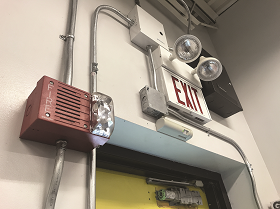

One of the biggest difficulties for security is how people affected by incidents respond in an emergency. This is partly due to many people thinking that something can never happen. When it does, they are clueless about what to do. Things like fire drills are often taken as an inconvenient administrative requirement, security requests to people to look after their bags at an airport or shopping mall as interfering. Managers of risk or surveillance have to deal with this psychological barrier, and also allegations of disrupting business, but have to ensure that people are protected or able to protect themselves.
I’ve previously written about the importance of response personnel, and also about the role of surveillance when an incident happens. However, the importance of trials, rehearsals or drills transcends these issues and has the potential to save a lot of people or reduce a lot of damage.
While doing a rehearsal in a shopping centre where we had a simulated fire, an actual fire alarm went off. However, there was difficulty establishing whether there was a camera able to view the area to confirm whether this was a real fire or false alarm and getting someone to the site was going to take some time. The implication is that a whole shopping centre may have been evacuated before establishing the degree of risk. This is why having standard procedures in a control room is so important so people have a structured way in responding to incidents, calling necessary support, and facilitating the evacuation process if need be.
My wife was in some offices when there were violent protests outside and there were fires in some adjacent buildings. Police responded and were telling people to evacuate the building, until somebody noted that would expose people directly to the aggressive protestors. At that stage, there was an intensive discussion about what would be the best action in this situation. If this scenario had been thought through before, much quicker decisions could have been made. In the end, because the fires were not directly affecting the building, workers stayed inside the offices for the protection they offered.
Prepare for the unexpected
At a behaviour analysis conference I attended in Minneapolis in the USA recently, one of the speakers was talking about a concert shooting where the fans immediately hit the ground when shots were fired. The problem was that the shooter was positioned high up in a building and shooting down into the crowd, and evacuation was the best strategy rather than lying down and being a static target. The organiser quickly realised the issue and started getting people moving away as soon as possible.
Thinking through what can happen and how one is going to respond, and then doing a rehearsal is an important factor in preparation. The expected approach isn’t always correct and these rehearsals give one a change to check out scenarios and explore some of the potential things that can happen outside the normal course of events.
Rehearsals or drills are important in testing whether the designated approaches work. This can be done on a small scale or on a full institutional basis. Finding fire doors are locked and nobody has the key when doing a response to a trial fire evacuation is an important discovery to safeguard people and rectify issues for when a real event may happen.
Cruise lines are an industry where safety and drills are taken seriously. Last year on the first day of the cruise I saw the value of this when everyone had to do the fire drill and follow the laid down procedure and evacuation routes. I saw two old gentlemen having an intensive discussion about which direction they were supposed to walk, which I assisted to resolve in passing. If that had happened in a real fire, the indecisiveness and confusion could have been fatal. Global warming is producing a number of extreme events that we are going to have to be more and more prepared for.
No-one is safe from potential attacks
The same behaviour analysis conference I mentioned highlighted the issues relating to terrorism and active shooters in the US, and the specific concerns which needed to be addressed and responded to under such conditions in a range of environments. The importance of doing drills or rehearsals is obviously important in US schools, but also in religious institutions which are often the target of extreme attacks from various parties.
Many synagogues in the US, for example, have drills of how to respond to an active shooter and this has saved lives in at least one active shooter incident when people hid away or escaped through designated routes. Looking at how to respond to bomb attacks is similarly reviewed in depth in anything from shopping malls to religious institutions in the US. The world is no longer as safe as it once was no matter where you are.
The role of on-the-ground people to facilitate evacuation or protection is also critical. In armed robberies I’ve viewed, you find a typical pattern of people running away, including unarmed security personnel. In one casino robbery, I witnessed one of the service staff talking to an elderly couple carefully shepherding them away from the affected area. Thinking like that under that kind of pressure was truly remarkable.
The risk organiser at the concert shooting event in Las Vegas was talking about how he first recognised the shots over the music and even the type of weapon, and pinpointed where the shooter was (based on military experience). He then became actively involved (at the potential expense of his own life) in shouting directions, giving guidance, showing people the way, giving them roles and keeping them moving. These types who become agents should be part of any evacuation strategy and should be equipped with the skills and insights to deal with such situations and crowds. Fire marshals, for example, should be equipped with these practical kinds of skills to facilitate their role in actual events.
Monitoring after the event
From a surveillance point of view, what happens afterwards is also essential to monitor. Are there evacuated people who look like they need to be prioritised for treatment? Are there suspicious people in the crowds? Are actions or movement of people within expected ranges etc? If a fire or other event happens in a site processing precious metals or diamonds or even a shop, and normal security protocols have to be abandoned as part of the evacuation, is there any behaviour that potentially shows people in possession of stolen material? I’ve watched video in the aftermath of casino robberies where clients have attempted to steal chips, or in shops where they have attempted to take goods from the store during a robbery happening around them.
CCTV surveillance control rooms have a role in assisting risk management when they have generated the scenarios, auditing the drills or rehearsals, identifying choke points or blockages in evacuations, coordinating responses, and in some cases even using public announcement facilities to assist. Similar activities happen during the actual event, with the speed and effectiveness of processing depending on use of available standard procedures, plans, and experience in taking the people through from practice sessions to real life events.

Verification of behaviour and presence of people during or after a real life incident can also be an important element. The rehearsal of concept (ROC) drill has been used extensively in the military, but is just as important when facing risks in organisations and institutions to protect people on the ground.
Dr Craig Donald is a human factors specialist in security and CCTV. He is a director of Leaderware which provides instruments for the selection of CCTV operators, X-ray screeners and other security personnel in major operations around the world. He also runs CCTV Surveillance Skills and Body Language, and Advanced Surveillance Body Language courses for CCTV operators, supervisors and managers internationally, and consults on CCTV management. He can be contacted on +27 11 787 7811 or craig.donald@leaderware.com
| Email: | sales@leaderware.com |
| www: | www.leaderware.com |
| Articles: | More information and articles about Leaderware |

© Technews Publishing (Pty) Ltd. | All Rights Reserved.